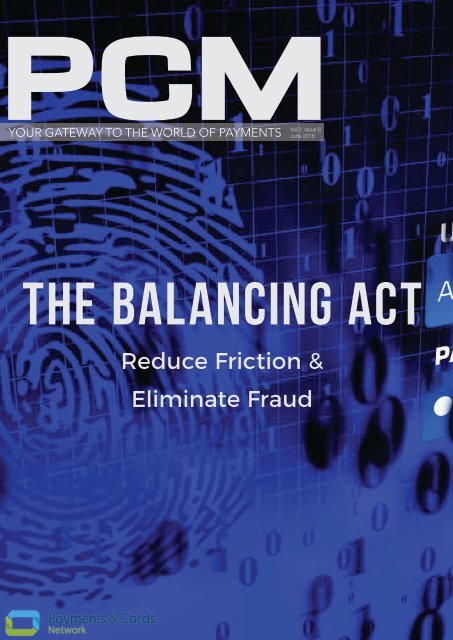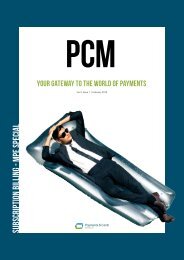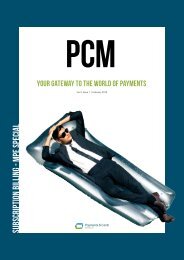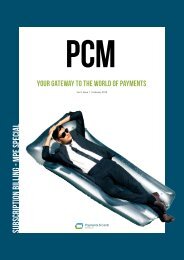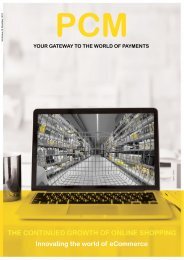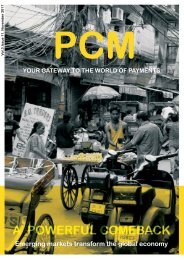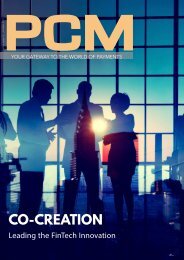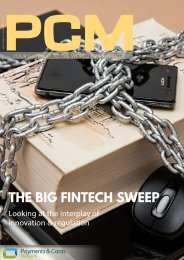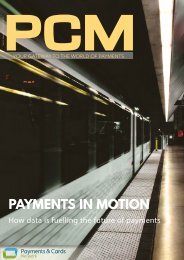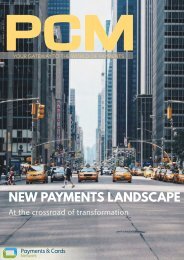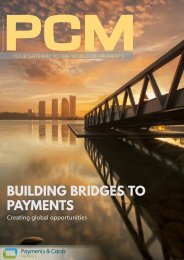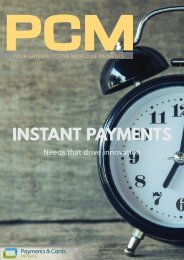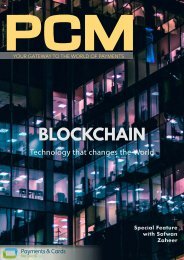PCM Vol.2 - Issue 6
Create successful ePaper yourself
Turn your PDF publications into a flip-book with our unique Google optimized e-Paper software.
<strong>PCM</strong><br />
YOUR GATEWAY TO THE WORLD OF PAYMENTS<br />
Vol 2. <strong>Issue</strong> 6<br />
June 2016<br />
The Balancing act<br />
Reduce Friction &<br />
Eliminate Fraud
Welcome to <strong>Vol.2</strong> - issue 6<br />
We are enthusiastic to release the 6th <strong>Issue</strong> of the Payments & Cards Network<br />
eMagazine for 2016. Following our last issue, this month we focus on the way realtime<br />
data can be utilized to reduce friction and eliminate fraud in the Payments<br />
industry and further. In light of this, we present an Q&A session with Armen Najarian,<br />
CMO at ThreatMetrix, who talks about the digital transformation in the financial<br />
services industry.<br />
In the Startup Spotlight we introduce you to Risk Ident, a software provider offering<br />
anti-fraud solutions within the e-commerce, telecommunication and financial sector.<br />
Roberto Giorgio Valerio, CEO at Risk Ident, sheds light on his company’s innovative<br />
approach to tackle fraud, which goes beyond having advanced machine learning<br />
components.<br />
To provide a complete picture of the digital transformation in the financial service<br />
industry, Luke Reynolds, Director of Fraud at FeatureSpace, clarifies what machine<br />
learning is and how it can exactly be used to tackle online fraud.<br />
Carrying on we feature the Michel Splichal, MRC US Program Manager, who gives<br />
advice on how risk management departments can foster an excellent customer<br />
experience. And on top of this Jose Gonzales-Alonso, Head of European professional<br />
services for Payments solutions at NCR, explains the advantages of using Bayesian<br />
analytics to fight fraud more effectively.<br />
Finally, an overview of the hottest job openings we have at the moment. Feel like you<br />
need a change or looking for a job opportunity? Get in touch directly by clicking on<br />
the jobs. For the ones who like to network or simply want to stay up-to-date with their<br />
peers - check out our premium event partners and make use of the discounts we<br />
have on offer before they run out!<br />
For any questions, suggestions, or concerns, please address them to the editors:<br />
Amir Abdin - amir@paymentsandcardsnetwork.com<br />
Duc Dang - duc@paymentsandcardsnetwork.com<br />
Joanna Bak - joanna@paymentsandcardsnetwork.com<br />
The Payments & Cards Network team wishes you good reading!<br />
002
Contents<br />
thoughtleaders<br />
spotlight<br />
7 16<br />
10<br />
13<br />
STORIES<br />
4<br />
7<br />
10<br />
13<br />
Fractals - The future of fraud detection<br />
Jose Gonzales-Alonso dives deep into new approaches and techniques of<br />
fraud detection.<br />
How is Machine Learning helping to tackle online<br />
fraud<br />
Luke Reynolds explains what the popular term of machine learning and how it<br />
can be utilized to fight fraud.<br />
Ways for Risk Management team to provide a<br />
winnnig customer experience<br />
Michel Splichal shares a number of strategies a risk department can<br />
implement to sustain a excellent customer experience.<br />
Understanding the total costs of friction<br />
Armen Najarian highlights the importance of preserving the overall customer<br />
experience while improving to detect & fight fraud.<br />
16<br />
19<br />
20<br />
Spotlight: Risk Ident<br />
We speak to Risk Ident, a very innovative startup taking<br />
fraud prevention to the next level.<br />
Hot Jobs<br />
Hottest jobs in the industry! Get in touch directly to get<br />
more insight.<br />
Events<br />
Here we showcase the most exciting upcoming events<br />
related to FinTech, Payments and Cards throughout<br />
the world!<br />
003
Thought Leaders Corner<br />
by Jose Gonzalez-Alonso<br />
Fractals - The Future of Fraud Detection<br />
Fraud exists in many forms across the financial<br />
industry and its losses are not getting any smaller.<br />
Figures from the Nilson Report revealed that<br />
in 2014 the global loss of payment card fraud<br />
reached over $16 billion which is an increase of<br />
19% in comparison to the previous year, 2013 .<br />
Criminals operate in highly organised gangs,<br />
targeting the weakest links in the payments<br />
“chain”. It may be a data breach, skimming<br />
devices, phone scams, fake websites, intercepting<br />
mail, phishing online bank accounts or hacking.<br />
There are many, ever-changing, ways to get past<br />
the security.<br />
At the same time as criminals have changed their<br />
methods and techniques, the fraud detection<br />
technology also has evolved. Nowadays, financial<br />
institutions have more tools and techniques<br />
available to fight fraud. For instance big data<br />
analytics, which enables analysing huge data sets<br />
and identify anything out of the ordinary. Despite<br />
this fact, fraud is not going away.<br />
The customer at the heart of fraud detection<br />
It is vital for financial institutions to accurately<br />
identify and proactively stop fraudulent<br />
transactions in order to protect their customers<br />
and keep the losses to a minimum. After all,<br />
financial institutions are the main defender of<br />
the customers and most clients expect their<br />
banks to track and stop fraud. But things aren’t<br />
as simple as that. Today’s customers also expect<br />
their banks to always get it right, meaning that<br />
the customers have a low tolerance for a “false<br />
positive” situation in which the financial institution<br />
blocks a genuine transaction in the mistaken<br />
belief that it is fraudulent.<br />
This means that banks have to find the perfect<br />
balance between a system that is so “strict” that<br />
it blocks genuine transactions, having a negative<br />
impact on customer experience, and taking an<br />
approach that is more passive and that might<br />
overlook genuine fraud.<br />
The answer lies in a combination of in-depth<br />
knowledge of the customer and a fraud detection<br />
system that is intelligent enough to learn and<br />
adapt as fraud changes.<br />
It is also crucial to know the customer well enough<br />
to immediately see if any of their activity is outside<br />
of their normal behaviour. This means that the<br />
financial institutions need to look at the full<br />
enterprise view of each individual to understand<br />
their historic activity across all channels (both<br />
financial and non-financial), taking into account<br />
the geographic and demographic profile as well<br />
as other influencers such as time of year.<br />
Fraud teams also need to consider factors such<br />
as channel. Figures from LexisNexis suggest that<br />
in 2014 m-commerce accounted more than one<br />
fifth of fraudulent transactions in the US, despite<br />
only making up 14% of transaction volumes.<br />
However, a transaction between a customer with<br />
an IP address that you know and a regularly used<br />
online merchant is presumably genuine.<br />
004
Thought Leaders Corner<br />
Fighting fraud with Bayesian analytics<br />
Effective fraud detection has many forms,<br />
from traditional rules-based approaches to<br />
sophisticated analytical models and machine<br />
learning.<br />
out from the crowd in its machine learning<br />
capabilities – the system can learn rapidly as<br />
frauds are tagged, constantly learning and selfcalibrating<br />
as fraud trends change. This means<br />
that fraud teams know that they are in the best<br />
possible position to identify and stop fraud when<br />
it happens.<br />
Within the industry, the most widely used<br />
analytical approach is to build Neural<br />
Network models using historic<br />
consortium data to build up a<br />
set of patterns to later use in<br />
detection of live card fraud.<br />
This approach has been used<br />
for many years with varying<br />
success. However, recently<br />
new approaches have become<br />
increasingly popular and have<br />
begun to overtake the results<br />
being achieved with traditional<br />
modelling techniques.<br />
NCR has pioneered a modern<br />
approach of fraud analytics,<br />
choosing to base its models<br />
on a more flexible Bayesian<br />
analytical technique. This<br />
methodology enables fraud<br />
teams to build models faster<br />
than it is traditionally possible,<br />
while achieving extremely<br />
good detection rates at low<br />
false positives.<br />
About NCR<br />
easier.<br />
The models form parts of the<br />
Fractals Adaptive Classification<br />
Engine, which provides automated, intelligent<br />
fraud detection using a combination of Bayesian<br />
statistical analysis and proprietary inference<br />
techniques. By applying mathematical models to<br />
each incoming transaction, the system identifies<br />
suspicious activity, calculates a probability-based<br />
fraud score that indicates the likelihood of fraud<br />
and then triggers an action.<br />
NCR Corporation (NYSE: NCR) is the global<br />
leader in consumer transaction technologies,<br />
turning everyday interactions with<br />
businesses into exceptional experiences.<br />
With its software, hardware, and portfolio of<br />
services, NCR enables more than 550 million<br />
transactions daily across retail, financial,<br />
travel, hospitality, telecom and technology,<br />
and small business. NCR solutions run the<br />
everyday transactions that make your life<br />
Unlike a Neural Network, which is nothing more<br />
than a “black box” that produces a score,<br />
Bayesian models produce scores that<br />
come with a clear set of reasons<br />
and probabilities. This “white box”<br />
approach gives the end user much<br />
more granular information to work<br />
with when assessing a transaction<br />
or speaking with a customer and, as<br />
we know, more information means<br />
better customer service - the key to<br />
successful fraud operations.<br />
Based on the risk score, pre-defined<br />
actions are triggered and the<br />
transactions are approved, rejected<br />
or referred. Custom rules can then<br />
be set for referred transactions. If<br />
an unusually large transaction is<br />
detected for a customer profile, the<br />
bank can inform the customer via<br />
SMS or e-mail about the suspicious<br />
transaction and get confirmation<br />
that the payment is authorized.<br />
Comparative tests have shown that<br />
the Bayesian models outperform<br />
industry standard solutions<br />
in detection rates and cause<br />
significantly fewer false positives. Enhanced<br />
with self-learning functions such models that<br />
can automatically adjust to new fraud scenarios.<br />
Fractals scores transactions in real time and can<br />
decline a transaction during the authorization<br />
request.<br />
The future of fraud<br />
The model is initially set and tuned using financial<br />
institution’s recent historical data and fraud tags<br />
so that it can identify the unique fraud patterns<br />
facing each unique organisation. The result is<br />
a bespoke and highly accurate fraud detection<br />
model that can be set up in just a few short<br />
weeks.<br />
Each model in the Adaptive Classification Engine<br />
is based on a series of mathematical algorithms<br />
that are targeted to identify specific fraud<br />
patterns or irregularities in the account’s holder<br />
behaviour. However, the system really stands<br />
The truth is that fraud isn’t going to disappear any<br />
time soon – criminals have got too much to lose.<br />
There will always be new breaches or techniques<br />
to get past even the strongest security and fraud<br />
systems. And, unfortunately, there is no solution<br />
which is the answer to every problem.<br />
However, a fraud system that can assess a<br />
transaction in real time, based on a comprehensive<br />
understanding of customers’ historic behaviour<br />
and intelligent analysis compared to the latest<br />
fraud trends, will arm your fraud team to stop<br />
the highest possible levels of fraud.<br />
005
ALWAYS ONE STEP<br />
AHEAD OF FRAUDSTERS ...<br />
Risk Ident is a software development company that offers<br />
anti-fraud solutions to European companies within the<br />
e-commerce, telecommunication and financial sector. We are<br />
experts in data analytics and machine learning. Let us show<br />
you how to improve your fraud prevention step by step!<br />
www.riskident.com
Thought Leaders Corner<br />
How is machine learning helping to tackle online fraud?<br />
It’s widely known in the financial services sector that<br />
criminals look for the weakest link in transactional<br />
systems for attempting fraud attacks. I was at the centre<br />
of UK banking when we rolled out Chip-and-PIN in the<br />
mid-2000s and saw the impact of this change on online<br />
fraud. With EMV rolling-out to the US last year, we’re<br />
already seeing online fraud spike – by 11% according<br />
to PYMNTS.com – as criminals perceive this channel<br />
as offering the biggest fraud ‘rewards’.To try and beat<br />
the criminals, financial services institutions need to<br />
understand all the data they’re collecting about their<br />
individual customers – and use this data for informed<br />
business decision-making. One term that we’re hearing<br />
used a lot to tackle analysing big data is ‘machine<br />
learning’. So what exactly is machine learning, and how<br />
is it being used to tackle online fraud?<br />
What is machine learning?<br />
In many industries – banking and payments included<br />
– machine learning has become a popular term. We’re<br />
particularly hearing it a lot in business areas that are already<br />
using advanced analytics methods to understand customer<br />
and business data.<br />
The promise of machine learning is that it can automate<br />
analysis processes – making it easier for financial services<br />
institutions to make decisions about their customers faster,<br />
and with more accuracy, than relying on human analysis alone.<br />
The kicker with machine learning is that the criminals are as<br />
sophisticated in these techniques as those of us who are trying<br />
to fight them off. It’s really tough to stay ahead, and we know<br />
that criminals look for the easiest targets when committing<br />
fraud. We need to beat them at their own game.<br />
Advanced computer science<br />
Machine learning is an area of computer science that studies<br />
how to make computers learn and improve with experience,<br />
with minimal human intervention. For example, being able<br />
to identify trends or patterns in large, complex quantities of<br />
data, with speed and accuracy – and then automatically adapt<br />
statistical models to incorporate these patterns and trends.<br />
This process enables computers to find insights from the data<br />
without being told where to look – this is what makes machine<br />
learning a branch of artificial intelligence.<br />
Fraud detection – detecting anomalies with machine<br />
learning<br />
So what does this mean for fraud detection and customer<br />
management? Well, the flip side of spotting and understanding<br />
data trends at high speed is that machine learning systems<br />
can also accurately and efficiently detect anomalies in these<br />
trends.<br />
This is crucial for fraud prevention. Human analysts are<br />
capable of looking at data to spot trends and anomalies, but<br />
do so very slowly. It takes us a long time to see the important<br />
changes in the data, and manually make adjustments to the<br />
007
Thought Leaders Corner<br />
Merchants also feel the impact of these inefficient fraud<br />
protection methods. They get hit hard by the resulting<br />
chargeback costs and fraud losses – not to mention to loss of<br />
revenue from declined transactions (false positives).<br />
Blocking genuine customers can’t be a cost of stopping<br />
fraud<br />
When good customers are blocked in an attempt to catch<br />
fraud it’s a problem for both customers and merchants.<br />
Recent research from MasterCard revealed that it’s often the<br />
most affluent customers that get blocked. For example, those<br />
who are travelling more frequently or making purchases with<br />
a larger transaction value. If these customers get blocked by<br />
outdated, inefficient fraud systems, there is a significant loss<br />
of both revenue and reputation for the financial services<br />
provider, and their merchants.<br />
Luke Reynolds,<br />
Director of Fraud at Featurespace<br />
Luke is responsible for Featurespace’s fraud clients in<br />
Financial Services and Insurance. Prior to Featurespace,<br />
Luke worked in the Financial Services sector for 20 years,<br />
including as Callcredit’s Commercial Director of Fraud and<br />
ID, a variety of roles in Lloyds Banking Group, the UK Card<br />
Association and NatWest.<br />
systems that rely on this data.<br />
Machine learning systems can do this much faster – looking<br />
at complex data sets and offering accurate predictions<br />
on behaviour, and a deep understanding of, for example,<br />
customer behaviour when making transactions online.<br />
Changing payments push-up online fraud<br />
Understanding individual behaviour patterns – and detecting<br />
anomalies – is especially important in the payments world,<br />
where processes are changing fast and protecting merchants<br />
and customers involves analysing vast amounts of data.<br />
As soon as financial institutions and their merchants get up to<br />
speed with a payments change – such as Chip technology or<br />
contactless cards – another change seems to be coming.<br />
Reducing customer friction: advanced fraud management<br />
needed<br />
So, it’s clear that financial institutions are under pressure to be<br />
providing a seamless, secure experience. Modern customers<br />
want fast, efficient methods of payment and don’t want to be<br />
blocked when making a genuine transaction.<br />
This brings us back to the promise of machine learning.<br />
Organisations need fraud systems that can interpret vast<br />
volumes and complex aspects of customer behaviour –<br />
quickly and efficiently – while reducing customer friction with<br />
a seamless experience.<br />
What I’ve learnt from over 20 years battling fraud is that<br />
financial institutions need fraud systems which keep one step<br />
ahead by understanding every individual customer’s behaviour<br />
in real-time – protecting them from fraud, while providing a<br />
frictionless experience. This is where machine learning steps<br />
in.<br />
How are sophisticated machine learning systems better<br />
than humans?<br />
Preventing fraud with advanced deep machine learning<br />
systems is enabling organisations to balance robust fraud<br />
Don’t let fraud prevention drop in priority<br />
Having worked for over twenty years’ in risk and security in<br />
the banking sector, it’s been my experience that as financial<br />
institutions and their merchants get to grips with new payment<br />
processes, fraud prevention drops down the priority list.<br />
This means that changes to payments ultimately negatively<br />
impact the customer. What should be a positive move<br />
for convenience, in reality causes a knock-on impact on<br />
increasing the risk of fraud attack. To try and counter this risk,<br />
organisations often increase the dial on their fraud protection<br />
limits – meaning more genuine customers feel the friction of<br />
having transactions incorrectly blocked in an attempt to catch<br />
fraud.<br />
008
Thought Leaders Corner<br />
checks with a frictionless customer experience. Machine<br />
learning systems automate the process of viewing events<br />
in context, building a deep understanding of every single<br />
customer. By monitoring every event and transaction taking<br />
place in real-time and from multiple channels, fraud attacks<br />
stand out and genuine customers are easy to recognise – all<br />
from an automated fraud prevention system. It’s an approach<br />
being adopted by TSYS, the largest payment processor in<br />
the United States. TSYS wanted to strengthen its position in<br />
faster payments using machine learning to provide clients<br />
with actionable insights in real-time. They’re implementing<br />
an advanced machine learning engine to protect their clients<br />
from fraud while providing a seamless customer experience.<br />
capability to predict behaviour one step before the criminals<br />
think of new ways to behave.<br />
It’s up to organisations to embrace new fraud systems to gain<br />
a vital competitive edge in protecting their customers and<br />
their reputations.<br />
Staying one step ahead<br />
Advanced machine learning systems are the way forward<br />
for financial institutions to stay ahead of the criminals. It’s<br />
important to take action now to reduce fraud while providing<br />
frictionless customer experience and protecting revenue.<br />
Fraud attacks globally are going to increase online and via<br />
mobile channels – you don’t need a computer science degree<br />
or a PhD in machine learning or statistics to predict that.<br />
My advice to companies tackling fraud is to make sure that<br />
your fraud prevention software is built by guys who have the<br />
Featurespace<br />
www.featurespace.co.uk<br />
Featurespace is the world-leader in Adaptive Behavioural Analytics and creator of the ARIC engine, a<br />
machine learning software platform developed out of Cambridge University, which understands individual<br />
behaviours in real-time for enhanced fraud detection decision-making capabilities. Customers include<br />
TSYS, Callcredit, Betfair, KPMG, Vocalink/Zapp, Camelot, and William Hill.<br />
009
Thought Leaders Corner<br />
Ways for Risk Management Departments to<br />
Provide a Winning Customer Experience<br />
by Mike Splichal, MRC US Program Manager<br />
It is generally calculated that businesses<br />
must spend between four and ten times<br />
more to acquire a new customer than<br />
to keep an existing one [1]. With that<br />
in mind, we would like to share several<br />
strategies risk departments can employ<br />
to help deliver a strong customer<br />
experience, an important component of<br />
customer loyalty.<br />
Remove direct links from the body<br />
of your department's emails -- If<br />
customers need to take a particular<br />
action, such as resetting their password,<br />
or should visit a specific resource, such<br />
as a help page, give customers the<br />
steps or the path instead of providing<br />
a direct link. Much has been done to try<br />
to educate consumers on the peril of<br />
clicking URLs in emails; including links<br />
can become both a customer trust issue<br />
and drive additional contacts to your<br />
department -- or to Customer Service<br />
-- questioning the validity of the email.<br />
Involve your social media points of<br />
contact -- More and more customers<br />
are choosing to interact with companies<br />
using social media. Whether Customer<br />
Service, Marketing or another team<br />
monitors your company’s social media<br />
accounts, ensure the relevant POCs<br />
know who to engage for any fraud,<br />
risk or security issues received via<br />
Facebook, Twitter or other channels. If<br />
your company does not already have<br />
an internally accessible contact matrix,<br />
creating one and reviewing it at least<br />
quarterly is a good place to start.<br />
Strengthen your CS relationship<br />
-- Meet periodically with appropriate<br />
personnel in Customer Service<br />
leadership to discuss any important<br />
fraud/risk trends, projects or events<br />
which may lead to CS contacts. Also,<br />
coordinate with CS on regular updates<br />
to their account security training so<br />
CS associates keep current on topics<br />
related to fraud and risk, such as social<br />
engineering.<br />
Keep communication concise and<br />
personalized -- Unless the customer's<br />
scenario involves a legal issue, risk<br />
investigators should refrain from using<br />
generic templates that come across<br />
as "blurbs" or contain extraneous<br />
information irrelevant to the situation at<br />
010
Thought Leaders Corner<br />
Work towards a continuous<br />
feedback loop on rules/models -- In<br />
partnership with the analysts, data<br />
scientists or solution provider(s) who<br />
maintain your rule sets and/or machine<br />
learning models, continually assess<br />
false positives and dive deep at the<br />
first sign of an anomaly. Transactions<br />
inappropriately queued for manual<br />
review can delay orders unnecessarily;<br />
transactions cancelled erroneously are<br />
especially problematic and may result<br />
in an escalated customer service case.<br />
Operational input can play an important<br />
role in fine-tuning rules and models,<br />
leaving good transactions out of manual<br />
review queues and letting investigators<br />
focus on those transactions which truly<br />
are risky.<br />
Network with other risk professionals<br />
-- By joining a professional organization<br />
like the Merchant Risk Council, key<br />
fraud and payments personnel<br />
can gain valuable insights, discuss<br />
emergent threats and trends, and<br />
share best practices with other industry<br />
professionals. The MRC offers numerous<br />
opportunities to connect and learn: in<br />
person, via four annual conferences<br />
and multiple smaller networking<br />
events; and virtually, through MRC<br />
Communities, a portal which enables<br />
quick communication and timely<br />
feedback between fraud and payments<br />
professionals around the globe.<br />
Conclusion<br />
Mike Splichal,<br />
MRC US Program Manager<br />
Mike coordinates content for committees,<br />
presentation archives and community forums.<br />
He also develops member training and<br />
certification programs. and NatWest.<br />
hand. Your customers' time is valuable, so<br />
limit emails to two or three paragraphs if<br />
possible, and consider using help pages<br />
to display more detailed information, if<br />
needed, about policies and procedures.<br />
Shorter emails also display more easily<br />
on mobile devices, perfect for customers<br />
on the go.<br />
Implement customer-friendly<br />
technology -- Two-factor authentication,<br />
where a one-time use code is sent to<br />
the consumer’s cell phone via SMS or<br />
a special app, is an effective way to<br />
help protect customer accounts and<br />
confirm legitimacy. Enhancing mobile<br />
apps to permit customers to log in<br />
using fingerprints or facial recognition is<br />
another way to provide a simple, secure<br />
means of authenticating users.<br />
While preventing illegitimate transactions<br />
from being completed is a critical part of<br />
a risk department’s mission, it is equally<br />
important that legitimate customers<br />
have a safe shopping experience with<br />
as little friction as possible. We believe<br />
increased focus on good customers is<br />
a winning strategy for any eCommerce<br />
business, and will pay handsome<br />
dividends through increased loyalty and<br />
sales in the years ahead.<br />
Sources:<br />
1 = Kingwill, Ian (2015). What is the Cost of Customer Acquisition vs Customer Retention? Retrieved from: https://www.linkedin.com/pulse/<br />
what-cost-customer-acquisition-vs-retention-ian-kingwillwhat-cost-customer-acquisition-vs-retention-ian-kingwill<br />
About MRC:<br />
The MRC is an unbiased global trade association providing a<br />
platform for eCommerce fraud and payments professionals<br />
to come together and share information. As a not-for-profit<br />
entity, the MRC’s vision is to make commerce safe and<br />
profitable everywhere by offering proprietary education,<br />
training and networking as well as a forum for timely and<br />
relevant discussions.<br />
Find more information and visit:<br />
http://www.merchantriskcouncil.org<br />
011
Your window to enter<br />
the Realm of<br />
Data Science Gurus<br />
CONNECTING YOU WITH THE PEOPLE TO POWER YOUR BUSINESS EFFICIENCY<br />
CONTACT US NOW<br />
Having data dilemmas? Please contact: simon@digitalsource.com or visit www.digitalsource.io<br />
Digital Source | Herengracht 576 | 1017 CJ | Amsterdam | The Neterlands | +31 (0) 202 373 639
expert interview<br />
Understanding the<br />
Total Cost of Friction<br />
Armen leads worldwide marketing strategy and<br />
execution for ThreatMetrix. Previously, he directed<br />
the go-to-market strategy for IBM’s $1B portfolio of<br />
100+ SaaS solutions. Armen joined IBM through<br />
the $440M acquisition of DemandTec, where as VP<br />
of Corporate Marketing he built a modern demand<br />
generation engine and repositioned the business<br />
supporting a 3x increase in revenue over a 5 year<br />
span.<br />
Armen Najarian<br />
CMO, ThreatMetrix<br />
Tech-savvy millenials are<br />
becoming the predominant<br />
demographic as customers as<br />
well as employees. We talk to<br />
Armen Najarian from ThreatMetrix,<br />
about the right balance of remaining the<br />
competitive with new tech innovation<br />
whilst not compromising the customer<br />
experience.<br />
PCN: When you talk about ‘Digital<br />
Transformation’ in the Financial<br />
Services industry, what does that mean<br />
to you?<br />
AN: Digital Transformation as it relates<br />
to fraud and security breaches is no<br />
longer just an IT issue, it’s a business<br />
issue. Banks don’t typically measure<br />
the cost of friction but the tangible<br />
losses are in the billions. Banking and<br />
Commerce transactions are increasingly<br />
done online or via mobile devices and<br />
we’re putting our personal information<br />
out there at an accelerated rate. This<br />
creates greater opportunity for fraud<br />
and security breaches.<br />
When fraud occurs two things happen: 1.<br />
the industry responds by implementing<br />
stricter authentication measures -<br />
passwords, captchas, verification<br />
codes - that end up hampering the<br />
user experience, and 2. customers lose<br />
trust. Adding more hoops for users to<br />
jump through degrades their experience<br />
enough that they can be willing to walk<br />
away - creating financial loss. On the same<br />
hand, loss of customer trust means that<br />
they won’t be recommending services to<br />
friends and family, and that also results<br />
in financial loss. Digital transformation<br />
effectively addresses business concerns<br />
and IT concerns, minimizing customer<br />
friction while tackling fraud.<br />
PCN: In March, 2016, First Annapolis<br />
conducted a study* on behalf of<br />
ThreatMetrix on controlling friction<br />
while tackling cybercrime. What<br />
surprised you most about the data?<br />
AN: There were a couple of things. The<br />
sheer volume of individuals using digital<br />
means for important transactions, and<br />
the high cost of loss due to fraud and<br />
friction. In our study, 38% of people<br />
reported experience with banking and<br />
payments fraud within a 3-year period.<br />
66% had their payment card information<br />
compromised, while 45% said their<br />
information was used to make online<br />
or mobile purchases. Because of fraud,<br />
90% took actions to secure their account<br />
and 34% changed their behavior, but<br />
10% actually left their bank. Of the<br />
demographics, millennials were more<br />
inclined to take action as a result of real<br />
or perceived problems.<br />
Let’s talk about that 10%. Assume that<br />
of 215.1MM banked consumers, 9%<br />
experienced fraud in the last 12 months.<br />
That’s 19.4MM fraud victims, of which,<br />
the 10% that left/will leave amounts to<br />
around 1.9MM relationships lost. No<br />
matter what the dollar value of those<br />
relationships, that’s a staggering loss.<br />
PCN: As a consumer, wouldn’t you<br />
rather go through challenges than risk<br />
compromising your identity and data?<br />
AN: The Catch-22 for the industry is that<br />
the cost of fraud and fraud prevention<br />
is significant, but so is the cost of<br />
friction created by customer-facing<br />
step-up challenges. The study shows<br />
that fraud and the customer response<br />
to it don’t vary much by geography<br />
or demographics. The majority of<br />
013
individuals don’t perceive mobile<br />
transactions to be as safe as in-person<br />
or even online transactions regardless<br />
of increasing security barriers. That’s<br />
important information for the banking<br />
and ecommerce.<br />
The traditional method of adding<br />
increasing measures of security, i.e., stepup<br />
challenges, puts the burden back on<br />
consumers and introduces a potential<br />
point of failure in the relationship. 83%<br />
of our study respondents said that they<br />
had experienced step-up challenges in<br />
the past year, with nearly 50% saying it<br />
happens frequently.<br />
PCN: Of those 83%, what was their<br />
perception of the customer experience?<br />
AN: Consumers left their banks because<br />
the experience was too irritating.<br />
Forgetting usernames or passwords,<br />
getting locked out of their accounts...this<br />
is frustrating to consumers, especially<br />
on a mobile device where there is<br />
an expectation of immediacy and<br />
convenience. Increased authentication<br />
methods can lead to increased customer<br />
complaints, customer servicing costs,<br />
decreased account revenue if they leave,<br />
and lost customer relationships that cost<br />
the financial services industry billions of<br />
dollars.** It’s not enough to push the<br />
problem back on the consumers and<br />
there are consequences to that.<br />
PCN: Fraud and security challenges will<br />
likely escalate, how can the financial<br />
services industry keep up with the<br />
costs to themselves as well as their<br />
consumers?<br />
AN: The financial services industry<br />
needs to invest in both preventing fraud<br />
and preventing the friction that comes<br />
with the consumer-facing prevention<br />
techniques. In countries such as Europe,<br />
where EMV has long been in place,<br />
there are still significant rates of fraud<br />
and loss of consumer confidence. This<br />
finding underscores the fact that EMV<br />
isn’t the answer to all security and fraud<br />
challenges and step-up challenges are<br />
creating greater friction.<br />
This is what digital transformation is all<br />
about. Security and a positive digital<br />
Expert Interview<br />
experience are not mutually exclusive.<br />
It’s important to take a holistic approach<br />
to digital security. The net is that the<br />
financial industry has to do better to<br />
tackle ongoing threats while preserving<br />
the customer experience.<br />
*First Annapolis conducted a multi-market consumer survey<br />
based on a sample of 3,090<br />
consumers from the U.S., U.K., and Australia<br />
**Of the 83% experiencing step-up challenges, 3% will likely<br />
leave their bank as<br />
a result of friction. This equates to 3.9MM Relationships lost<br />
at an approximation of $2,533 Est. revenue remaining per<br />
relationship, or $10.0 Bn Lost Relationship Value<br />
ThreatMetrix®, The Digital Identity Company, is the market-leading cloud solution for authenticating digital personas and transactions<br />
on the Internet. Verifying billions of annual transactions supporting tens of thousands of websites and thousands of customers<br />
globally through the ThreatMetrix® Digital Identity Network, ThreatMetrix secures businesses and end users against account<br />
takeover, payment fraud and fraudulent account registrations resulting from malware and data breaches. Key benefits include an<br />
improved customer experience, reduced friction, revenue gain, and lower fraud and operational costs. The ThreatMetrix solution<br />
is deployed across a variety of industries, including financial services, e-commerce, payments and lending, media, government, and<br />
insurance.<br />
For more information about the study or related topics, please contact:<br />
Jaci Robbins, Director of Marketing, (jrobbins@threatmetrix.com)<br />
014
Spotlight<br />
You think you have what it takes to start a<br />
business in a super-hot market?<br />
<strong>PCM</strong> takes a close look at some of the most<br />
innovative and promising startup companies in the<br />
payment industry.
'WE MAKE NEW<br />
TECHNOLOGY<br />
APPROACHABLE...'<br />
Roberto Giorgio Valerio, CEO at Risk Ident GmbH, studied<br />
Business Administration but his programming history reaches<br />
far back. He started programming at the very young age and<br />
therefore he is very technically skilled for a business focused<br />
professional. Before Roberto started Risk Ident he was already<br />
involved in 3 other startups as a founder.<br />
to create a device fingerprinting solution in 6 months. The<br />
good news is that our team kept that promise and delivered<br />
on time. After being approved by the Otto Group, the initial<br />
project turned into a company in March 2013 and by now<br />
has become a leading provider of fraud prevention software<br />
within the online space.<br />
Where did the idea for Risk Ident originate and what’s the<br />
organization’s vision?<br />
Risk Ident started out as a project within Liquid Labs, an<br />
incubator of the Otto Group based in Hamburg, Germany.<br />
The Otto Group is second largest European online retailer. This<br />
company has an estimated 12 billion Euro annual turnover,<br />
roughly 7 billion of that is online retail. Within Liquid Labs the<br />
project team looked into different aspects where they could<br />
leverage the knowledge and data of the Otto Group. Actually<br />
Risk Ident was founded as Device Ident, which was a focused<br />
on device fingerprinting. The Otto Group’s goal at that point<br />
was to use device fingerprinting for its online shops.<br />
That’s the point where I came into play because I promised<br />
What sets you apart from other anti-fraud solution<br />
provider?<br />
Risk Ident was able to use the knowledge of the Otto Group<br />
and its great amount of historic data to built its first fraud<br />
prevention product. With tens of millions transaction every<br />
year having the Otto Group as a domain expert (including<br />
its years of experience of how fraud looks like) is a great<br />
advantage and benefit for Risk Ident.<br />
Even though the Risk Ident team consists out of mostly data<br />
science professionals and senior software engineers who<br />
did not have in-depth experience with fraud prevention or<br />
payments before, we were able to create some of the most<br />
technically advanced products for anti-fraud solutions on the<br />
market. The reason for that is that we might be seen as the<br />
016
startup spotlight<br />
latest to the game but we do use the latest technology that<br />
others weren’t using a couple of years ago.<br />
As the technical landscape is undergoing continuous change<br />
and innovation, we always try to be at the vanguard of that<br />
front. So, with more than half of the Risk Ident team being<br />
either data scientists or software engineers we focus mainly<br />
on a continuously evolving product that strongly benefits from<br />
the latest technology.<br />
Where does Risk Ident stand now and what’s on the<br />
horizon for the company?<br />
We currently have 50 clients which are mostly big enterprises.<br />
Our client group includes some of the biggest mobile network<br />
operators, big ecommerce stores (with at least 100-200 Million<br />
Euro annual turnover) Fintech companies as well as banks.<br />
I think we have a strong position in the German speaking<br />
markets and therefore have become one of the leaders on<br />
our home domain. We just started to venture into additional<br />
European market and at the beginning of next year we’ll also<br />
be operating in the US.<br />
Putting it into a startup environment perspective you<br />
commonly need three essential components to become<br />
successful. These include having a great team, building<br />
excellent products and eventually selling it to real clients. We<br />
have accomplished and gathered these vital startup elements<br />
and now it’s all about how to scale up our business. Moreover,<br />
we do target only larger companies who can use our tools to<br />
enhance their fraud protection.<br />
More importantly we realized that it doesn’t matter if<br />
we sell to a big German e-commerce player, a UK based<br />
telecommunication company or an US travel portal because<br />
many fraud cases are very similar in the way fraudsters<br />
operate. One of our advantage is that the tools we built<br />
are very agnostic to the market and will also work for other<br />
markets. The only thing we have to do is to train the tools<br />
with different data. For that reasons I’d say that we have good<br />
chances to expand to new markets on a global scale.<br />
In your experience of fraudulent transactions, what is the<br />
most common source of fraud?<br />
When talking about online retail there are two main aspects<br />
about fraud. On the one hand, there is the single fraud cases<br />
in which commonly people with bad credit score try to obtain<br />
goods. You can usually identify them by behavioral actions<br />
like changing their name or address and they try to get one<br />
product or service. In contrast to that there is the very harmful<br />
organized fraud. These people are very professional and<br />
oftentimes even do that illegal activities for a living. What is<br />
more, they don’t stop at e-commerce fraud alone, they would<br />
try to get to other people’s online loans or similar personal<br />
account information. Another fact why organized fraud is<br />
considered a lot more harmful than single fraud cases is that<br />
with the increasing number of fraud cases, the risk to have full<br />
complete loss scales up. Unfortunately, the trend of organized<br />
fraud is becoming stronger right now. In conclusion organized<br />
fraudulent activities represent the bigger problem and risk<br />
for the merchants.<br />
Will upcoming regulations in Europe influence Risk Ident’s<br />
business, and how?<br />
Our main advantage in this regard is that our fraud prevention<br />
software can be installed on premise. That’s very handy when<br />
we talk with banks for instance, as they are working with very<br />
sensitive customer information which banks won’t share with<br />
third parties. And even the large e-commerce customers with<br />
the big data breaches that happened throughout the last years<br />
they were very reluctant to hand out their end costumer data<br />
to a third party. When working with our software the clients<br />
can install and integrate it on premise and they can train it with<br />
its data without sending out a single customer information.<br />
That is an immense value we can offer in comparison to other<br />
anti-fraud solution provider. In that light regulations are not a<br />
major challenge for us to overcome.<br />
How do you teach a machine to get smarter at identifying<br />
fraud?<br />
In the light of machine learning there is one major<br />
misconception. Many people say that their machine learning<br />
component of their product is like a secret ingredient. I think<br />
that the machine learning algorithm you use is not the main<br />
advantage. There are many rather simple algorithms that can<br />
be very good, such as Random Forest, Naive Bayes or Logistic<br />
Regression. However, there are two things which are more<br />
important than the machine learning component. First of all,<br />
it’s about the type of data you feed in – when feeding in lowquality<br />
data then you can only expect poor results. The other<br />
vital aspect is how to scale a machine learning system on a<br />
production level in terms of amount of data and response<br />
times. That’s why Risk Ident is very transparent about our<br />
machine learning components and sometimes we even tell<br />
our customers which specific set of algorithms we use on their<br />
data because we know how hard it is to provide it on a stable<br />
productive software solution and you need to know what you<br />
put in. The machine algorithm typically will only understand<br />
numbers, so you have to get your data pre-processed also<br />
017
startup Spotlight<br />
For more information please visit https://riskident.com/en/<br />
known as feature extraction. Examples: An address could be<br />
converted into a geolocation, an email could be evaluated by<br />
name, domain or general structure of the email. After that<br />
you need to know how to feed it to the machine learning box<br />
and only then you can obtain good results you can work with.<br />
To give an example for that, you can feed in an email<br />
address and the machine learning component can find other<br />
transactions with a similar email structure. Based on that I<br />
believe that the competitive advantage in our work space<br />
rather lies in how strong you are on the technology level,<br />
which contributes to your ability to build good software and<br />
ultimately making sure that the software is scalable.<br />
What are some best practices for business owners when<br />
it comes to protecting their customer’s information?<br />
Personally I think, that one of the best practices is educating<br />
your customers. By instructing them to not use the same<br />
password for all their different online shops and online services<br />
and reminding them to change the passwords occasionally<br />
and write them down. Simply because today it is much harder<br />
to get access to a paper note with written passwords than<br />
hacking into your laptop. To that end, it is paramount for all<br />
types of businesses to educate the end-customer about being<br />
prepared and careful about that sensitive information.<br />
Besides, not handing out any end-customer information is of<br />
vital importance. Fraud prevention can be done in-house by<br />
using on-premise software. Every time you let a third party or<br />
service access your end-customer data you risk customer data<br />
loss. Furthermore, try to store vital customer data encrypted:<br />
Businesses should use individual hashing for passwords and<br />
to be more specific they should be using individual salts to<br />
ensure the passwords cannot easily be decrypted even after<br />
customer data was stolen.<br />
The Risk Ident team always strives to enhance their products<br />
018
jobs<br />
Hot Jobs<br />
TECHNOLOGY PRODUCT<br />
MARKETING MANAGER<br />
Amsterdam | The Netherlands<br />
HEAD OF INTERNATIONAL<br />
BUSINESS<br />
Munich | Germany<br />
PRODUCT & BUSINESS<br />
DEVELOPMENT MANAGER<br />
Munich | Germany<br />
COUNTRY MANAGER<br />
FRANCE<br />
Home based in France<br />
COUNTRY MANAGER<br />
U.K.<br />
Home based in the UK<br />
COUNTRY MANAGER<br />
ITALY<br />
Home based in Italy<br />
PAYMENTS (OPERATIONS)<br />
PROGRAM MANAGER<br />
London | UK<br />
COUNTRY MANAGER<br />
SPAIN<br />
Home based in Spain<br />
INTERNATIONAL PAYMENTS<br />
MANAGER<br />
Amsterdam | The Netherlands<br />
SALES ENGINEER<br />
New York | United States<br />
RISK MANAGER<br />
Hong Kong | HK<br />
EMEA SALES MANAGER<br />
London & Dublin | UK / Ireland<br />
019
events<br />
Events<br />
Accra - Ghana<br />
This year’s theme is “Connecting people to Banking & Financial Service<br />
through Financial Inclusion”. This conference aims to make financial<br />
inclusion a reality for the masses. Through this event, all the key<br />
decision makers in the Banking and Finance sectors will be brought<br />
together as a way of facilitating the exchange of ideas, experiences<br />
and strategies that they have come across in their careers.<br />
1–2<br />
7–8<br />
London, United Kingdom<br />
After last year’s huge success, Digital Travel returns for its second<br />
year with an action packed 2-day agenda of interactive case studies,<br />
roundtables and workshops. The sole aim at the event is to provide<br />
a “how to” guide to transform your digital strategy to drive online<br />
revenue growth.<br />
London, United Kingdom<br />
Discount Code: PCN20<br />
PayExpo Europe is the ultimate event for anyone looking to make their<br />
payments process faster, easier and more secure. As the UK’s largest<br />
event, PayExpo attracts 2000+ attendees from over 50 countries<br />
and 700 different organisations who meet to network, learn about<br />
the ever changing payments landscape and make essential business<br />
contacts for the year ahead.<br />
7–8<br />
7–8<br />
London, United Kingdom<br />
The Center for Financial Professionals invite you to attend Vendor<br />
& Third Party Risk Europe, a two-day conference featuring an FCA<br />
KEYNOTE ADDRESS from Robin Jones, Head of Prudential Specialist<br />
Supervision, Financial Conduct Authority (UK). Plus don’t miss the<br />
opportunity to hear interactive discussions and presentations from<br />
over 20 senior risk experts.<br />
020
events<br />
Amsterdam, The Netherlands<br />
Discount Code: partner<br />
This large scale international conference hosts various cities,<br />
system operators, energy companies, industrial organizations and<br />
technological parties. They come together to share knowledge on how<br />
to achieve a Smart City. Projects where climate ambition and energy<br />
transition are the main focus point. Amsterdam Smart City is official<br />
host of the Smart City Event.<br />
7–10<br />
14 -15<br />
New York City, United States<br />
The Center for Financial Professionals invite you to attend Vendor &<br />
Third Party Risk USA, a two-day conference set to feature interactive<br />
discussions and presentations from over 20+ senior risk experts<br />
who will address; Regulatory Landscape, Defining Vendors, Due<br />
Diligence, Categorizing Vendors, Operational Risk, Documentation,<br />
CyberSecurity and much more!<br />
Victoria Island Lagos, Nigeria<br />
Intermarc Consulting hereby brings to you the annual CBN Cashless<br />
CardExpo Africa. The objective of this conference is to focus on the<br />
future of retail payment as well as promote and deepen the adoption<br />
and usage of electronic payment in Africa with the theme “Retail<br />
Payment & Ecommerce”.<br />
14 -16<br />
20 -21<br />
London, United Kingdom<br />
Retail Banking Analytics, is a two day event bringing together 150 retail<br />
banking professionals to discuss solutions for data management and<br />
cultural challenges and enable banks to define an agile, automated<br />
and actionable analytics strategy to improve profitability and<br />
enforce customer centricity in an increasingly digital and competitive<br />
landscape.<br />
021
events<br />
London, United Kingdom<br />
Discount Code: WMPCN10<br />
This landmark one-day summit at The British Museum assembles the<br />
most exciting, forward-thinking innovators and captivating thought<br />
leaders in money, banking and finance. The international lineup of<br />
speakers covers a fascinating range of topics including the evolving<br />
role of digital currencies, issues of security and trust, crowdfunding,<br />
friction-free transactions and the democratisation of investment and<br />
lending.<br />
23<br />
27-29<br />
Discount Code: BBF_PCN<br />
New York - United States<br />
Engage in an open dialogue with professionals at the forefront<br />
of biometrics. Come address the emerging challenges banks and<br />
financial institutions are facing regarding the adoption of biometrics<br />
and the integration of these technologies into mobile devices, online<br />
service applications, and ATM machines in order to ensure customer<br />
satisfaction and enhance security.<br />
London - United Kingdom<br />
Mondato Summit Europe is the mobile financial services and related<br />
commerce space, more succinctly termed Mobile Finance and<br />
Commerce (MFC), has witnessed the emergence of several inter- and<br />
intra-industry constellation service propositions, such as Apple Pay<br />
and CurrentC, which are shaking up the status quo.<br />
5–6<br />
022
Payments & Cards<br />
Network<br />
Driving Innovation through<br />
knowledge<br />
TALK TO US<br />
We value your feedback and ideas!<br />
If you’d like to discuss a specific topic,<br />
don’t hesitate to contact us.<br />
Get in touch today and maybe you will<br />
be featured in the next edition:<br />
Amsterdam Office<br />
Herengracht 576<br />
1017 CJ<br />
Amsterdam<br />
The Netherlands<br />
Email: info@<br />
paymentsandcardsnetwork.com<br />
Tel: +31 20 3030 257<br />
Fax: +31 20 8208 295<br />
Follow us now and stay up-to-date<br />
with the latest happenings in the<br />
payment world!


